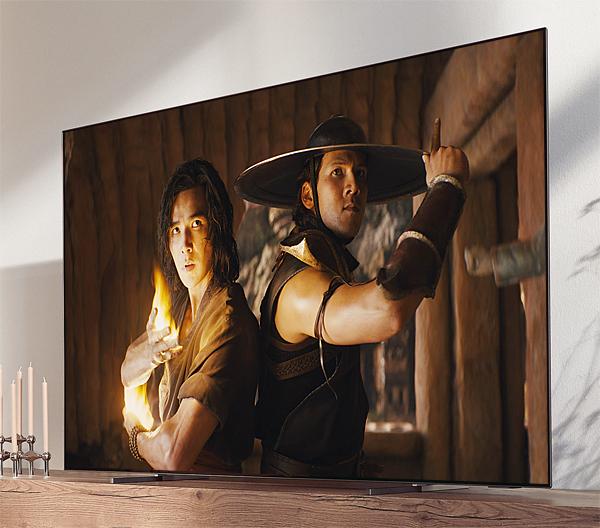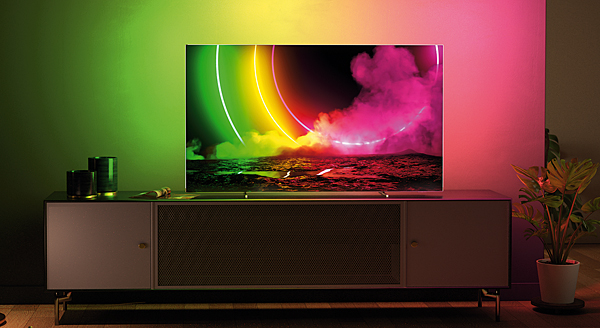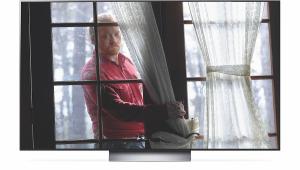Philips 55OLED806 OLED TV Review

 Philips' 800 Series OLED TV adds top-drawer gaming to excellent picture quality, discovers John Archer
Philips' 800 Series OLED TV adds top-drawer gaming to excellent picture quality, discovers John Archer
Philips' ability to harness its potent video processing to the innate precision of OLED display technology has, over the last half-a-decade or so, given the brand a new lease of life, and one that's seen it claim an ever-growing slice of the premium TV market in the face of competition from both established brands and aggressive newcomers. And I can't see it losing its grip if it continues to make TVs like those in its OLED806 range.
Auditioned here in 55in guise (there are also 48in, 65in and – new for this year – 77in options) this is a TV that boasts a lengthy feature list, familiar smarts, a tidy design and, naturally, Philips proprietary Ambilight illumination system (now four-sided, the iteration previously reserved for the company's range-topping tellies). It has serious kerb appeal.
Okay, there's a moment of unfair disappointment upon realising that the OLED806 range doesn't use one of the new breed of high-brightness OLED panels, as found on premium 2021 sets from LG and Sony. But the 55OLED806 isn't a premium model. It's a mid-range model, and at £1,600 is very keenly priced against those brighter rivals.
What's more, this Philips still records a startlingly high 940 nits (albeit in Vivid mode) on a white 10 per cent HDR window, which is in the same ball park as those aforementioned new high-brightness sets. Crucially, however, the TV only sustains its peak brightness momentarily before dropping to around 770 nits, suggesting that Philips is briefly 'overdriving' highlights to deliver a punchier HDR experience without damaging the panel.
HDMI Overhaul
The 55OLED806 is Philips' first TV with full-fat HDMI 2.1 inputs, meaning it can handle 4K/120Hz, Variable Refresh Rate and Auto Low Latency Mode gaming features. It delivers these abilities across two of its four HDMIs, which is probably fine for most people, and the VRR support extends to the AMD FreeSync Premium Pro and G-Sync systems, alongside the 'standard' HDMI Forum VRR.
There's also compatibility with the HDR Gaming Initiative Group (HGIG) system, which passes control of game HDR to your console or PC, and the 55OLED806 sees Philips finally getting serious about input lag. Here, 40/60Hz and 1080p/60Hz sources take just 15ms to render – less than half the time took on 2020's OLED805 set (HCC #313). This also drops to 8ms with 120Hz sources compared to around 25ms on the OLED805.
Turning to new video features, at the top of the tree is the fifth-generation of Philips' P5 AI Intelligent Picture Engine. This applies a dizzying roster of separate processing elements to what Philips sees as the five fundamental parts of picture quality: colour, source detection, contrast, sharpness and motion.
This latest P5 advance brings Philips' anti burn-in technology down to the 806 series, while the impressive AI content classification processing introduced on last year's range has been bolstered by new Ambient Light and Film Detection elements.

The former of those, as the name suggests, measures ambient light levels and adjusts contrast algorithms to deliver a more 'comfortable' viewing experience in darker rooms. Film Detection, meanwhile, can switch automatically either to the UHD Alliance's ultra-accurate Filmmaker Mode when the appropriate content flag is detected (although no such content seemingly exists), or to Philips' own Home Cinema Mode, which has been concocted to deliver an image that's sort of a mid-point between Filmmaker Mode and the heavily saturated, high-contrast Vivid preset.
The 55OLED806 also adds HDR10+ Adaptive support to the HDR10+, Dolby Vision and Dolby Vision IQ premium HDR systems the OLED805 TVs carried last year, enabling automatic adjustment of HDR10+ content to better suite ambient light levels.
Finally on the new feature front, Philips has a new Fast Motion Clarity setting that essentially introduces 120Hz Black Frame Insertion technology.
The TV's smart features are provided by the Android TV (v10) OS, although this will be upgraded to the new Google TV system at some unspecified future date. This is generally well-stocked, but there's currently no Dolby Atmos support from Disney+, or any sign of the Apple TV app. The latter is supposed to arrive soon, however, and it's great to see that unlike Sony at the time of writing, Philips' Android/Google TV implementation is joined by Freeview Play for terrestrial catch-up.
Jumping For Joypads
Unleashed on PS5 and Xbox Series X games as well as a wide range of video sources, the 55OLED806 proves to be a truly outstanding performer.
Gaming has finally become the deliriously fun experience I've long hoped Philips would eventually deliver. Native 4K 120Hz titles look spectacularly sharp and detailed, gorgeously and immersively fluid (especially with VRR active), beautifully rich in local contrast and dynamism, seriously responsive, and explosively vibrant.
 |
Home Cinema Choice #351 is on sale now, featuring: Samsung S95D flagship OLED TV; Ascendo loudspeakers; Pioneer VSA-LX805 AV receiver; UST projector roundup; 2024’s summer movies; Conan 4K; and more
|

















































